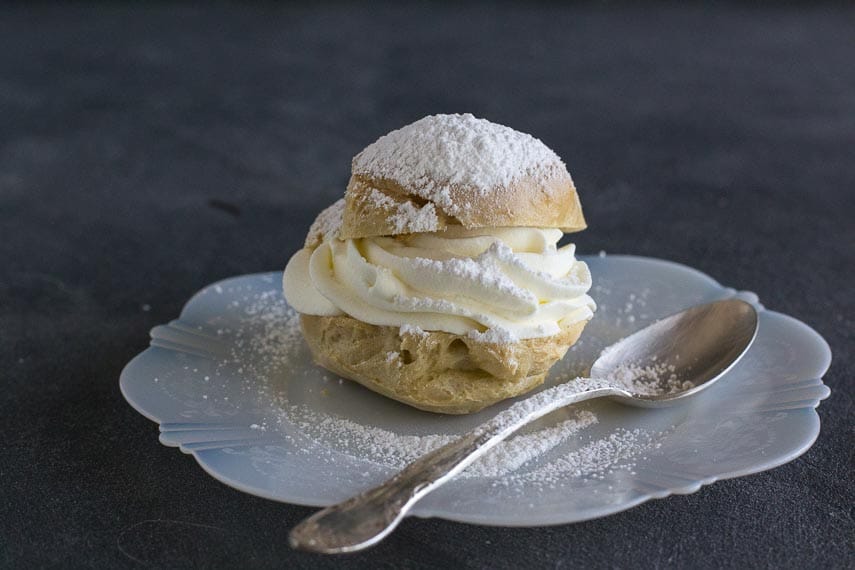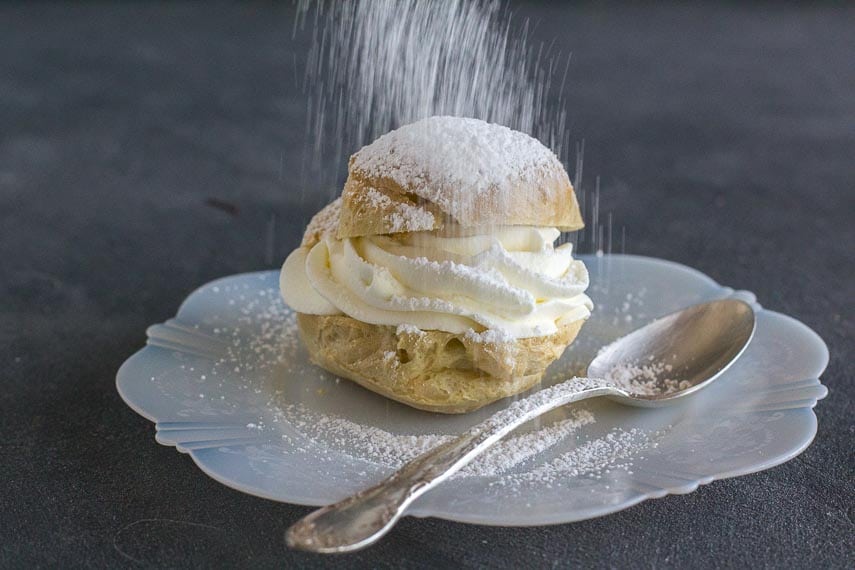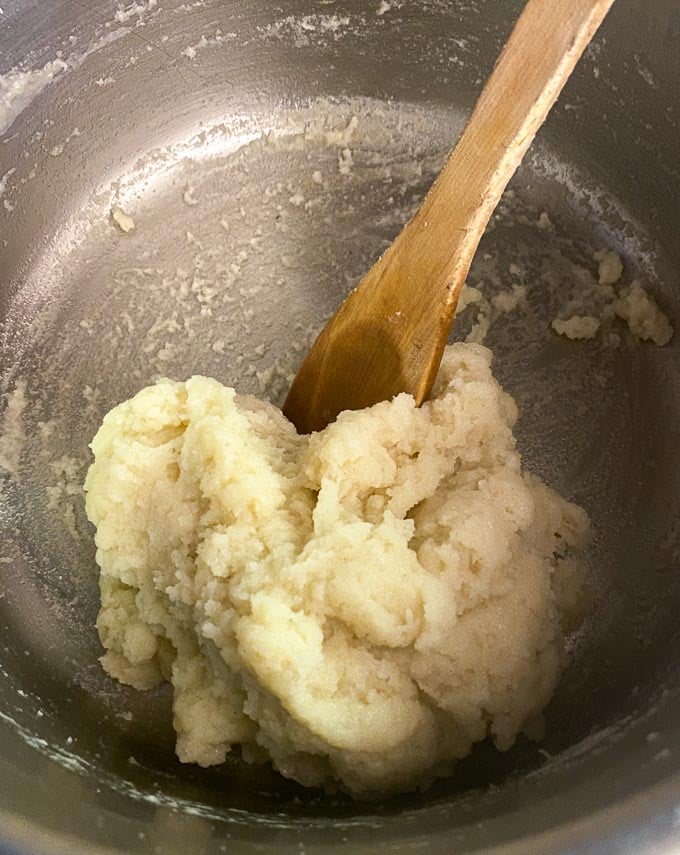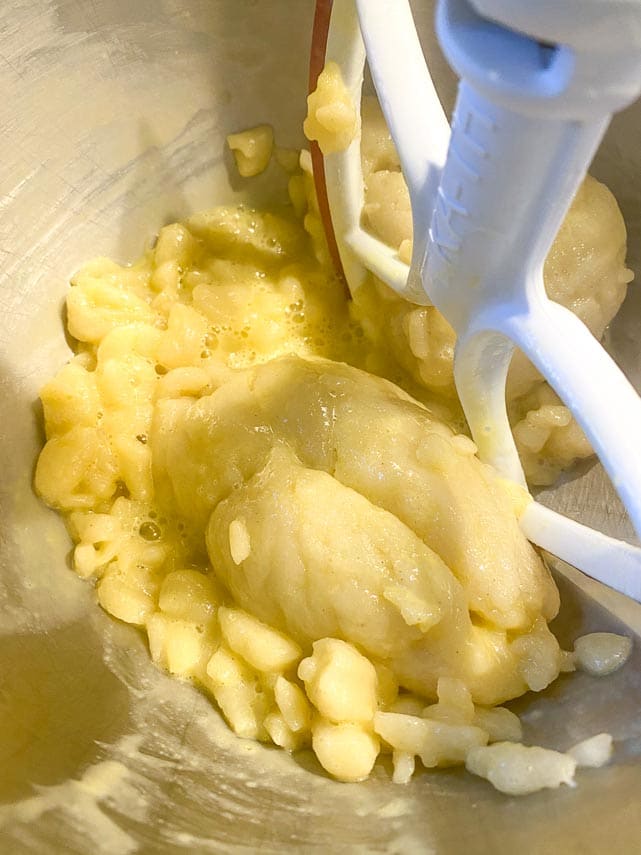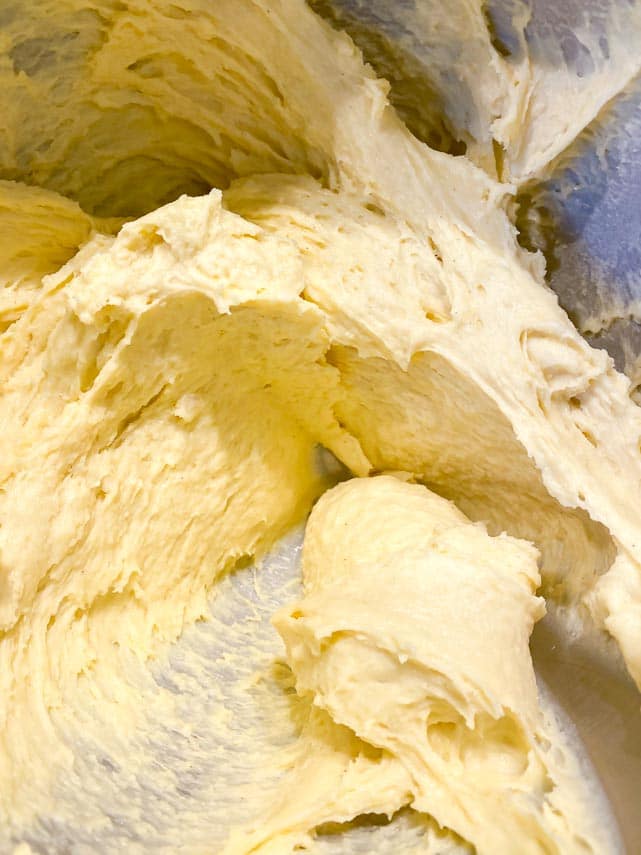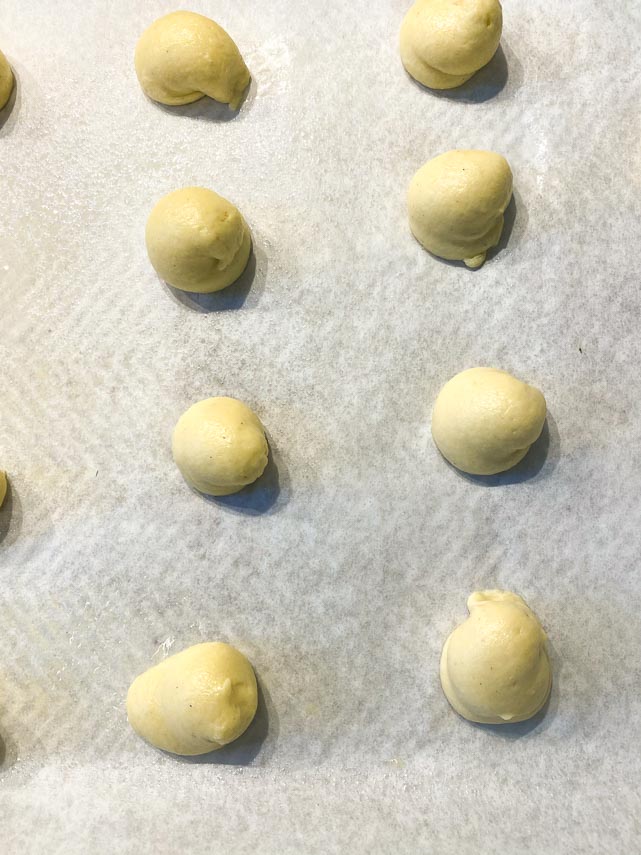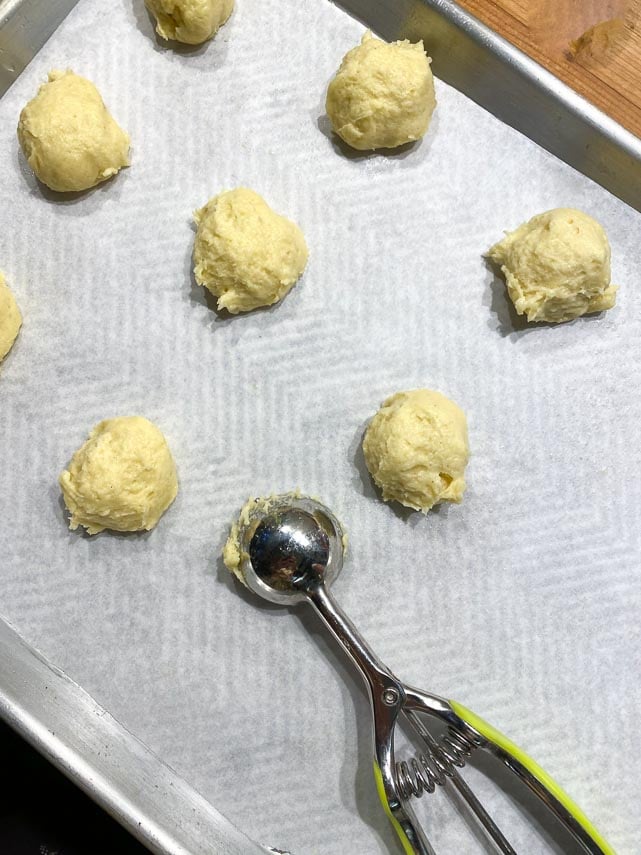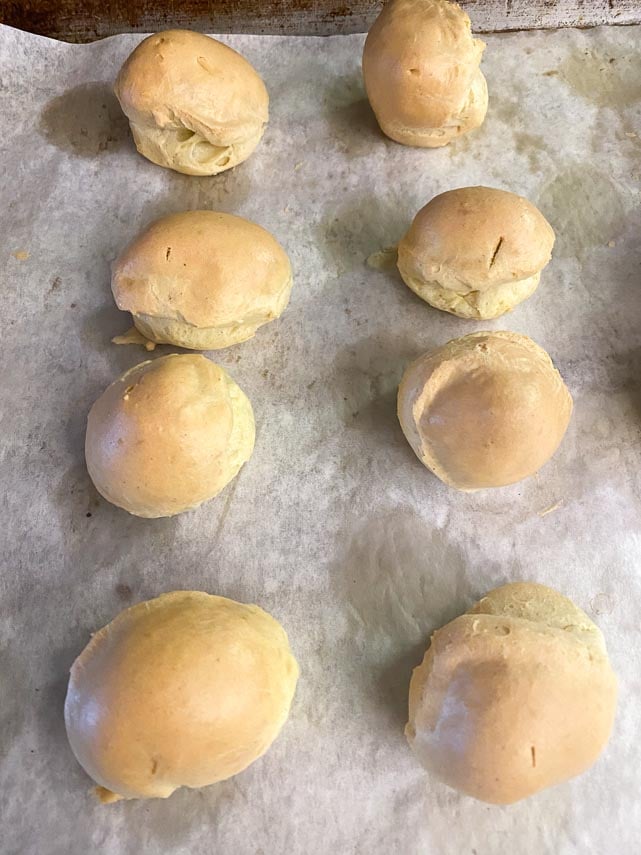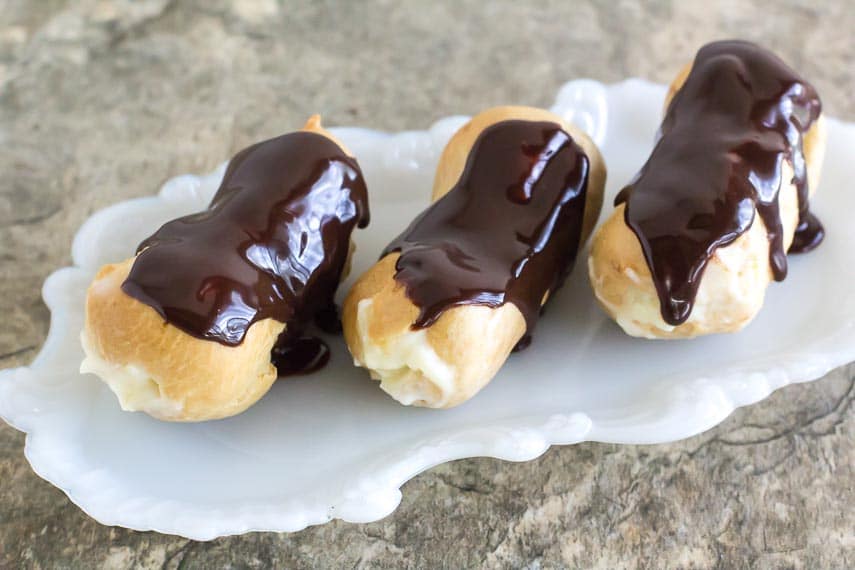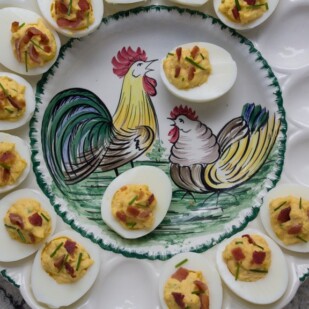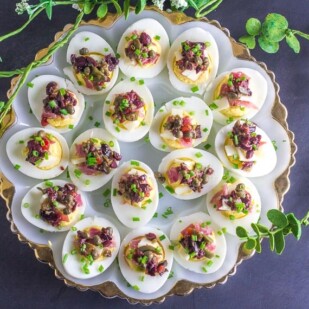Pâte à Choux is the classic basic pastry recipe that forms the basis of cream puffs, éclairs, croquembouche, profiteroles, gougères, St. Honoré, Paris-Brest and can also be fried to make crullers and beignets. It is made with easy-to-find ingredients, too: water, butter, flour, eggs and salt. No leavening agent is needed; the pastries rise via steam created inside the dough, helping it expand, yielding a crisp pastry on the outside with an airy middle.
How Do You Pronounce Pâte à Choux?
Say pä-tä-shu!
What Does Pâte à Choux Mean?
“Pâte means paste and “choux” means cabbage in French. The dough, or batter, is indeed a paste consistency. When piped into little rounds, as for cream puffs, it could be said that they look like little cabbages.
What Is Pâte à Choux?
Pâte à Choux is a classic French pastry recipe. It is not hard to make, and it is used to make cream puffs, éclairs, croquembouche, profiteroles, gougères, St. Honoré, Paris-Brest and can also be fried to make crullers and beignets. Common pantry ingredients – water, butter, flour, eggs and salt. Everything but the eggs is combined first on top of the stove and then beaten off the heat, either by hand or with an electric mixer, at which point the eggs are added, one at a time.
Then, the pastry is formed – usually by being piped out of a pastry bag into the desired shape(s). It is baked in a hot oven and the pastries expand. Towards the end of baking time, a small slit can be cut in the sides of each pastry to allow steam to escape and the inside can dry out a bit.
How Does Pâte à Choux Rise?
Pâte à Choux dough has a high moisture content, which creates steam during cooking that puffs up and expands the pastry. The high moisture content is achieved by boiling the water and butter together and then adding the flour. This technique causes the starch in the flour to gel, allowing the incorporation of the high proportion of water.
At this point most chefs switch to a wooden spoon and stir vigorously, cooking the mixture a few minutes to dry out. Then, the mixture is removed from the heat and eggs are beaten in, one at a time, allowing each to become incorporated.
Once the pâte à choux goes into a hot oven (formed into your chosen shapes), the steam and eggs work to create rise and expansion.
What Can I Make With Pâte à Choux?
You can make all sorts of sweet and savory things with pâte à choux, and it is easy to make low FODMAP renditions. We have a Croquembouche recipe for you and will be adding more that use this base recipe.
- Cream puffs – filled with all manner of sweet, creamy fillings – like whipped cream!
- Profiteroles – filled with ice cream, topped with chocolate sauce.
- Gougères – savory and cheesy.
- Eclairs – long, narrow, cream filled and topped with glaze.
- Gateau St. Honoré – a classic French pastry that can be made low FODMAP.
- Paris-Brest – a ring shaped French pastry featuring cream puffs and a circle of pâte à choux.
- Croquembouche – a tower of filled cream puffs, held together with hard caramel.
- French Crullers – the airiest, fancy doughnut you have ever tasted.
- Beignets – the classic confectioners’ sugar dusted pastry, perfect with coffee
- Churros – the batter for this cinnamon/sugar coated treat is similar to pâte à choux.
Making Pâte à Choux
Pâte à Choux sounds fancy, doesn’t it, but luckily the preparation is easy – just follow the recipe with specific ingredients, mixing and baking techniques.
Position rack in middle of oven. Preheat oven to 400°F (200°C). Line a half-sheet baking pan with parchment paper. Very lightly coat with nonstick spray; set aside.
Combine the water, butter and salt in medium sized saucepan. Bring to a rolling boil over medium-high heat, swirling a few times to make sure butter is melted, and immediately remove from heat.
Quickly stir in the flour all at once. Keep stirring with a wooden spoon until the batter comes together. Place over very low heat and keep stirring. You want the dough to dry out. This will take about 30 seconds; the pâte à choux should come cleanly away from the sides of the saucepan. Scrape dough into bowl of mixer fitted with flat beater attachment. Don’t worry about anything that stuck to the bottom of the pan.
Turn on low-medium speed and add eggs one at a time, allowing each egg to be absorbed before continuing. In the image below, the eggs are resisting being incorporated. Just keep beating!
Turn speed to medium-high and keep beating until batter comes together and become smooth and sticky and firm enough to hold a shape when mounded with a spoon.
Scrape dough into pastry bag fitted with tip.
For Cream Puffs & Profiteroles: Pipe out 14 puffs, about Ping-Pong or golf ball size, evenly spaced apart on baking pan. If the dough is sticky and resists coming away from the tip, simply use a sharp knife or even scissors to help. Dip fingertip in water and lightly press down any peak that has formed on the puffs; you want them to have a rounded appearance. You can also dole out the dough with a small scoop. I prefer the piping method.
For Éclairs: Pipe out 10 oblong shapes, about 3-inches (7.5 cm) long, evenly spaced apart on baking pan. If the dough is sticky and resists coming away from the tip, simply use a sharp knife or even scissors to help. Dip fingertip in water and lightly press down any peak that has formed on the éclairs; you want them to have a smooth appearance.
Bake for about 20 to 30 minutes or until light golden in color, puffed and crisp. Insert a sharp knife into the side of each puff or éclair to allow steam to escape. Turn the oven down to 350°F (180°C) and continue to cook for about 5 minutes. They should be high, rounded, light golden brown and dry.
Cool pan completely on rack. Puffs are ready to use. Alternatively, place in zipper-top freezer bags and freeze up to 1 month. Take care not to let them get crushed during storage. Defrost at room temperature. Fill and/or glaze as directed in individual recipes.
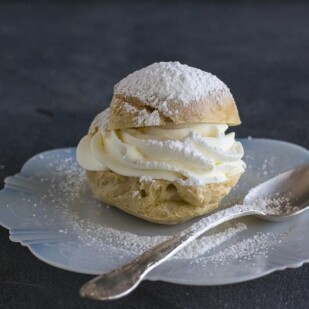
Low FODMAP Pâte à Choux
Pâte à Choux is the classic basic pastry recipe that forms the basis of cream puffs, éclairs, croquembouche, profiteroles, gougères, St. Honoré, Paris-Brest and can also be fried to make crullers and beignets. It is made with easy-to-find ingredients, too: water, butter, flour, eggs and salt. No leavening agent is needed; the pastries rise via steam created inside the dough, helping it expand, yielding a crisp pastry on the outside with an airy middle.
Low FODMAP Serving Size Info: Makes 14 small cream puffs or profiteroles or 10 éclairs; serving size is 2 puffs; 2 profiteroles; 1 éclair. Serving: 2 puffs; 2 profiteroles; 1 éclair
Ingredients:
- ½ cup (120 ml) water
- 3 tablespoons unsalted butter, cut into pieces
- ⅛ teaspoon salt
- ½ cup (73 g) low FODMAP gluten-free all-purpose flour, such as Bob’s Red Mill Gluten Free 1 to 1 Baking Flour
- 2 large eggs, at room temperature
- Pastry bag
- ½- inch (12 mm) plain round Decorating Tip, such as Ateco #806 or Wilton #1A
Preparation:
-
Position rack in middle of oven. Preheat oven to 400°F (200°C). Line a half-sheet baking pan with parchment paper. Very lightly coat with nonstick spray; set aside.
-
Combine the water, butter and salt in medium sized saucepan. Bring to a rolling boil over medium-high heat, swirling a few times to make sure butter is melted, and immediately remove from heat.
-
Quickly stir in the flour all at once. Keep stirring with a wooden spoon until the batter comes together. Place over very low heat and keep stirring. You want the dough to dry out. This will take about 30 seconds; the pâte à choux should come cleanly away from the sides of the saucepan. Scrape dough into bowl of mixer fitted with flat paddle attachment. Don’t worry about anything that stuck to the bottom of the pan.
-
Turn on low-medium speed and add eggs one at a time, allowing each egg to be absorbed before continuing. Turn speed to medium-high and keep beating until batter comes together and become smooth and sticky and firm enough to hold a shape when mounded with a spoon.
-
Scrape dough into pastry bag fitted with tip.
-
For Cream Puffs & Profiteroles: Pipe out 14 puffs, about Ping-Pong or golf ball size, evenly spaced apart on baking pan. If the dough is sticky and resists coming away from the tip, simply use a sharp knife or even scissors to help. Dip fingertip in water and lightly press down any peak that has formed on the puffs; you want them to have a rounded appearance.
-
For Éclairs: Pipe out 10 oblong shapes, about 3-inches (7.5 cm) long, evenly spaced apart on baking pan. If the dough is sticky and resists coming away from the tip, simply use a sharp knife or even scissors to help. Dip fingertip in water and lightly press down any peak that has formed on the éclairs; you want them to have a smooth appearance.
-
Bake for about 20 to 30 minutes or until light golden in color, puffed and crisp. Insert a sharp knife into the side of each puff or éclair to allow steam to escape. Turn the oven down to 350°F (180°C) and continue to cook for about 5 minutes. They should be high, rounded, light golden brown and dry. Do not under-bake or they willnbe soggy and leaden.
-
Cool pan completely on rack. Puffs are ready to use or can be held for 24 hours at room tamperature. Lightly cover with foil. Alternatively, place in zipper-top freezer bags and freeze up to 1 month. Take care not to let them get crushed during storage. Defrost at room temperature. Fill and/or glaze as directed in individual recipes.
Notes:
Tips
FODMAP Information
Our recipes are based on Monash University and FODMAP Friendly science.
- Butter: Both Monash University and FODMAP Friendly have lab tested butter. Monash states that a low FODMAP Green Light portion is 1 tablespoon or 19 g and also states that “butter is high in fat and does not contain carbohydrates (FODMAPs)”. FODMAP Friendly gives it a “Pass” at 1 tablespoon or 19 g. Both recommended serving sizes are presented as part of healthy eating guidelines, not as maximum FODMAP serving size. Fat can affect guy motility and trigger IBS symptoms in some people. Eat to your tolerance.
- Eggs: Eggs are high in protein and do not contain carbohydrates, according to Monash University.
Please always refer to the Monash University & FODMAP Friendly smartphone apps for the most up-to-date lab tested information. As always, your tolerance is what counts; please eat accordingly. The ultimate goal of the low FODMAP diet is to eat as broadly as possible, without triggering symptoms, for the healthiest microbiome.
Nutrition
All nutritional information is based on third-party calculations and should be considered estimates. Actual nutritional content will vary with brands used, measuring methods, portion sizes and more. For a more detailed explanation, please read our article Understanding The Nutrition Panel Within Our Recipes.
